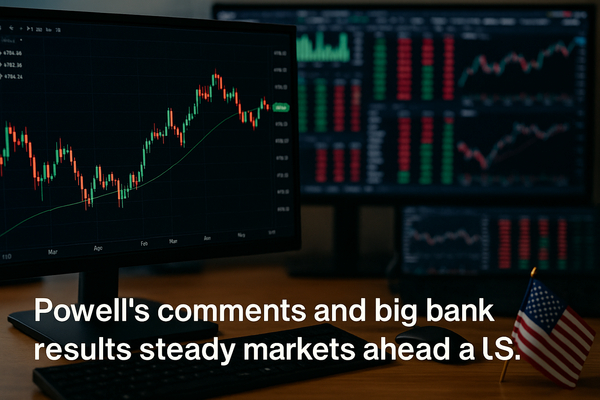
Markets steady on Powell comments and bank results. Federal Reserve Chair Jerome Powell reassured investors that the economy appears on firmer footing while noting a weak job market, calming a recent bout of volatility. Strong earnings from major banks are lifting financial shares in the short term, while renewed U.S.-China trade frictions and signs of future oil oversupply are reshaping risk sentiment for the weeks ahead. Globally, the moves matter for U.S. markets that lead trading, for European and Asian investors watching bank earnings and currency flows, and for emerging markets exposed to trade and commodity swings. The timing is critical because Powell’s remarks and fresh corporate reports arrived just as traders reassess rate cut expectations.
Market backdrop: steadying after a volatile stretch
U.S. stocks recovered from early losses as Powell’s comments eased worries about tighter financial conditions and left the prospect of Fed rate cuts on the table. Major indexes saw mixed results. The S&P 500 closed slightly lower while the Dow held gains and the Nasdaq lagged as tech shares pulled back. Volatility spiked, with the Cboe Volatility Index climbing to its highest level in nearly five months before trimming some gains. That bungee-like trading over the prior sessions highlighted how political headlines and policy signals can swing sentiment quickly.
Risk appetite also reacted to renewed U.S.-China trade frictions, which pushed investors toward safe havens. Treasury yields moved lower on those worries, reflecting demand for duration as traders reassessed growth and trade risks. The immediate consequence has been a rotation away from the top-weighted information technology space and into cyclicals, especially financials and industrials.
Bank earnings set the tone for equities
Quarterly reports from the banking heavyweights helped reorient market flows. JPMorgan Chase (NYSE:JPM), Goldman Sachs (NYSE:GS), Citigroup (NYSE:C) and Wells Fargo (NYSE:WFC) reported results that painted a mixed but constructive start to earnings season. Wells Fargo and Citigroup were cited as rising sharply, while shares of JPMorgan and Goldman were lower on the day. Financials became the best-performing S&P 500 sector on the session as investors parsed balance sheet trends and dealmaking commentary.
Those earnings carry short-term importance because banks serve as a barometer for credit conditions and loan demand. In addition, investors are keen to see whether trading, investment banking and consumer lending trends can offset margin pressures. The message from the initial reports was enough to lift confidence that earnings season can provide incremental support to markets, even as broader macro risks linger.
Sectors, single names and drivers to watch
Industrial names outperformed, helped by Caterpillar (NYSE:CAT) after a price target increase from an analyst at JPMorgan. At the other end, information technology underperformed with market cap leader Nvidia (NASDAQ:NVDA) sliding sharply. That contrast underlines how sector leadership remains fragile and subject to headlines that affect risk appetite and growth expectations.
Commodities also shaped market tone. Oil prices tumbled after an International Energy Agency warning of a significant supply glut in 2026. The drop in crude softened inflation concerns at the margin and supported the decline in Treasury yields. Gold continued to rally and set a new record high, driven by rising expectations for a near-term Fed rate cut and demand for safe havens. In crypto markets, bitcoin fell to as low as $110,023.78 and was last down about 1.9 percent after hitting a record above $126,000 on October 6.
Currency moves and bond yields reflect risk repricing
The U.S. dollar eased as investors rotated into perceived safety outside the greenback. The Swiss franc and Japanese yen gained after the trade frictions surfaced, drawing flows into traditional havens. The euro found support following a separate domestic development in France, where the government proposed suspending a major pension reform, reducing some political uncertainty in the short run.
On the curve, U.S. Treasury yields declined as traders priced in slower growth expectations and the possibility that the Fed will be more accommodative than previously anticipated. Powell’s comments that the economy may be on firmer footing but that the labor market was not strong undercut the case for immediate tightening. He also suggested the Fed could halt its balance sheet runoff, which eased concerns about excessively tight financial conditions.
What could move markets in the next session
Investors face several near-term catalysts. Bank of America (NYSE:BAC), Morgan Stanley (NYSE:MS) and United Airlines (NASDAQ:UAL) are scheduled to report earnings. Those releases will extend the earnings narrative and could influence bank stock performance and travel-related sectors. Numerous Fed officials are due to speak, and markets will parse each comment for clues on the timing and size of potential rate cuts. A recent Trump appointee to the Fed Board, Stephen Miran, is slated to appear at a CNBC forum in Washington D.C., adding to the policy focus.
Trade policy developments remain a wildcard. Washington and Beijing have already rolled out tit-for-tat port fees for ocean shipping, and prior threats over rare earth export controls and steep tariffs have contributed to the volatile tone of recent sessions. Traders will watch for further steps on tariff policy or other trade measures that could reprice global supply chain costs and corporate outlooks.
The coming session should therefore be informative rather than definitive. Powell’s remarks and the first wave of bank results have calmed some immediate market fears, but a mix of earnings, Fed commentary and trade headlines could reignite spikes in volatility. For now, the balance between stronger financial sector data and renewed geopolitical frictions is what will determine whether investors press higher or retreat into safer assets.
Graphics and refreshed data were noted in the original market brief. This preview is focused on the themes and items that traders and portfolio managers are likely to monitor as U.S. markets open and corporate news flows continue to shape sentiment.












